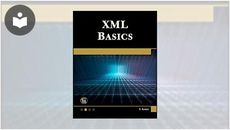Beginning XML, 3rd Edition
- 16h 53m
- David Hunter, et al.
- John Wiley & Sons (US)
- 2004
Now firmly established as a mature technology with numerous applications, XML has spawned additional functionalities, each with its own specifications. This edition of the highly popular guidebook for beginning XML programmers teaches you not only what XML is and how to use it, but also how it partners with XPath, XSLT, XQuery, XHTML, and others.
You’ll learn XML basics, then explore an XML-based programming language that enables you to transform XML documents into different formats. You’ll discover how to query databases for XML information, publish XML documents on the Web, and create interactive forms and graphics with XML. By the end of this book, you will feel confident applying XML in real-world situations.
What you will learn from this book
- Basic concepts of XML and how to define elements, tags, and attributes
- Rules for naming and structuring elements to produce well-formed XML
- How to validate XML using Document Type Definitions (DTDs)
- Guidelines for structuring documents with DTDs, XML schemas, and RELAX NG
- How to use XPath and XSLT to process documents
- Communication techniques using RSS, Web Services, SOAP, and WSDL
- Ways to manipulate documents for display with XHTML, CSS, SVG, and XForms
Who this book is for
This book is for any programmer interested in learning to use XML. Some knowledge of Web programming or data exchange techniques is helpful but not necessary.
In this Book
-
Beginning XML, 3rd Edition
-
Introduction
-
What Is XML?
-
Well-Formed XML
-
XML Namespaces
-
Document Type Definitions
-
XML Schemas
-
RELAX NG
-
XPath
-
XSLT
-
XQuery, the XML Query Language
-
XML and Databases
-
The XML Document Object Model (DOM)
-
Simple API for XML (SAX)
-
RSS and Content Syndication
-
Web Services
-
SOAP and WSDL
-
XHTML
-
Cascading Style Sheets (CSS)
-
Scalable Vector Graphics (SVG)
-
XForms
-
Case Study 1: .NET XML Web Services
-
Case Study 2: XML and PHP




